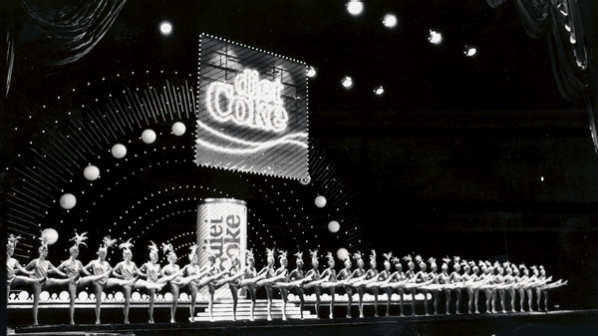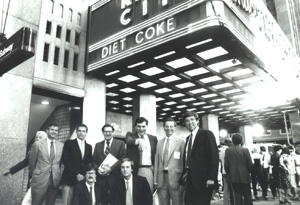The Extraordinary Story of How Diet Coke Came to Be: The Coca-Cola Company
The Rockettes perform at Diet Coke’s global premiere in July 1982.In the summer of 1980, a Coca-Cola planning manager named Jack Carew was tapped to lead a project that had been percolating within the company for two decades but never came to fruition – to introduce a “diet” version of Coca-Cola.Until that point, extending the Coca-Cola Trademark to another brand had been a no-no. But times had changed. Soft drink consumers were gravitating to low- or no-calorie brands, and the company’s business in the U.S. was struggling following years of inflation and rising costs, resulting in inefficiencies.
Members of the Diet Coke team beneath the Radio City Music Hall marquee before the filming of the brand’s debut TV commercial.“We needed a big idea to come out of one of the toughest decades we’d ever seen,” Carew explains.
Diet Coke was pegged a top priority. The project was strictly top secret; only a handful of senior executives knew about it, and team members had to agree to the assignment before getting the details.
“It was an entrepreneurial, cloak-and-dagger operation in the purest sense,” said Jerry Bell, who worked with Carew in the Planning Department. “
I remember getting this weird phone call from Jack… and I couldn’t say no.”Within a few weeks, they presented a draft study to Coca-Cola USA President Brian Dyson, followed by Roberto Goizueta, who had been elected Chairman and CEO just months earlier, President Don Keough and Chief Marketing Officer Ike Herbert.
No Risk, No Reward
Goizueta green-lighted the Diet Coke project, which shifted quickly from planning to implementation.
“This was a difficult decision because there were two big risks,” Carew said. “TaB was the moneymaker at the time, so if Diet Coke turned out to be a disappointment, the company would seriously complicate its future. Second, if senior leadership said no to Diet Coke, then we likely would have lost cola position.”Despite concern that Diet Coke would cannibalize TaB – which was the No. 1 diet soft drink brand in the U.S. at the time – and erode the long-term health of the Coca-Cola Trademark, the team’s research concluded just the opposite.
Colas accounted for 60 percent of all soft drink sales in the U.S. back then, but diets were growing three times faster than the rest of the category. Diet Coke was seen as the right product for the right time.“We said Diet Coke would be more accretive to Coca-Cola brand value, because we would source volume from the competition versus the Coke franchise,” said Pat Garner, who joined the Diet Coke team with 10 years of bottler and field marketing experience. “And we were right.
”What’s in a Name?
The team debated over whether to adopt the “diet” prefix – the label Nielsen had given to the relatively new category because the term was used in the names of two of its top three brands. “Sugar Free” was one alternative, but many saw it as a slur on Coca-Cola’s main ingredient. And “Light” was already taken by a competitor brand.Diet Coke was the most straightforward articulation of the promise of the brand. “It just seemed like the logical answer,” said John Farrell, who joined the team from Corporate Finance. “The equity of the Coca-Cola name promised the delivery of taste, and ‘diet’ told you it didn’t have sugar or calories.”For many years, the brand name was written and marketed as diet Coke – with a lowercase “d” – to reinforce the positioning of the product. Coke’s trademark lawyers wouldn’t allow the uppercase “D.”Their reasoning: Diet with an uppercase “D” was a noun, and the use of a noun changed the name of the trademark. Use of the lowercase “d” was an adjective and, therefore, did not alter the legal basis of the trademark.
A Plan that Pays
As the positioning began to come together, Farrell built a financial model to demonstrate the link between the brand’s marketing activities and bottler revenue. The plan motivated the system and turned bottlers into full-fledged Diet Coke enthusiasts.“John’s model made us highly credible,” Carew said. “We’d present our marketing plan to a bottler, and then he’d explain how it would pay out.”As Farrell explains it, “The economics of Diet Coke were so unbelievably simple because it didn’t have any sugar. When you remove the second-highest cost item after aluminum cans, you can make the numbers trend pretty well. Diet Coke gave us dramatically accelerated growth in a growing category with a very high-margin structure.”
‘Just For the Taste of It’
The initial can design included bold red letters against a white background with diagonal pinstripes.The financial model gave Coca-Cola USA the confidence to invest in marketing the brand. Steve Norcia, a former executive at the McCann Erickson ad agency, and his team at SSC&B – a division of Interpublic – crafted the ad campaign that would introduce and sustain Diet Coke in its first year.“We positioned it as a great-tasting soft drink that happens to have one calorie, rather than as a diet drink that tastes great,” Norci
So much more to this story at the source: The Extraordinary Story of How Diet Coke Came to Be: The Coca-Cola Company

